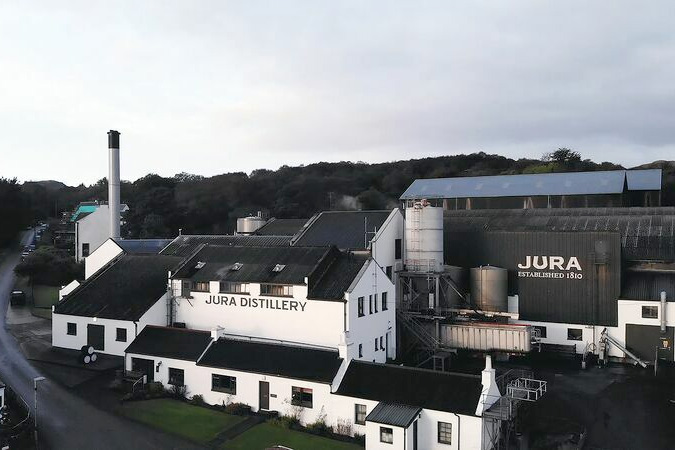Jura’s story
The island of Jura is located off the west coast of Scotland. The island is home to the Jura distillery, one road that runs from north to south, one village called Craighouse, one pub and two famous mountains known as The Paps of Jura. The distillery is owned by Whyte & Mackay and underpins the local economy and environment, not just by suppling employment but also whisky related tourism.
Jura is a relatively large distillery compared to the size of the island on which it is found, producing 2.5 million litres per year. Much used to go to the popular Whyte & Mackay blends, but they are now actively promoting their single malts with a resulting large growth in sales and reputation.
The whisky industry was an important part of Jura’s culture, even before a legal distillery was built there. The island was a hotbed of illicit distilling, due to its remote location and difficulty to reach. A number of caves around the coast were used to house small illegal stills and legend says that even when the excisemen did visit, the locals smuggled whisky to nearby Islay and the mainland by strapping containers of whisky to the underside of their cattle.
Jura’s history
In 1810 a local man, Archibald Campbell, saw an opportunity to make money from whisky and built the first legal distillery on Jura in its only village, Craighouse. The original name was Small Isles Distillery – a reference to the numerous small islands in Craighouse Bay, which the new distillery overlooked. Small Isles produced a heavy, smoky style of whisky similar to those made on the neighbouring island of Islay. The water for production was taken (and still is) from the dark, peaty Loch A-Bhaile Mhargaidh, which is 300m (1000 feet) above Craighouse.
In 1875, the distillery was taken over by James Ferguson & Sons. He put together a rescue package – the distillery had been struggling for a number of years as the previous two owners had been decalred bankrupt. By 1901 Small Isles had again fallen on hard times and following a rent dispute with the distillery’s land owner, James Ferguson & Sons decided to close down. They removed all distilling equipment and even the roof, so to prevent his landlord from seizing anything and selling it on.
The shell of the distillery lay derelict until 1960, when two local land owners decided to rebuild it and bring it back to life. Robin Fletcher and Tony Riley-Smith combined their love of whisky and a concern for Jura’s declining population (just over 100 people remained at that point) and employed renowned mid-century distillery architect William Delmé-Evans to redesign. Production restarted in 1963 with the distillery renamed as Jura. It produced a much lighter, fresher spirit than before. Current owners, Whyte & Mackay, have reintroduced a mild peatiness to the new make spirit and this now features in the domestic and travel retail core ranges.
- How to pronounce Jura? joo-rah
- Country: Scotland
- Region: Islands – Jura
- Founded: 1810
- Current owners: Whyte & Mackay
- Production capacity per year: 2.5 million litres
- Mash tun: 5 ton
- Washbacks: 6
- Stills: 4
- Visitor centre: Yes
Jura Distillery
Craighouse, Jura
Argyllshire
PA60 7XT
tel – +44(0)1496 820240
www.jurawhisky.com
Did you know?
The name of Jura comes from the Nordic meaning ‘deer island’. The name was given by the Vikings, who discovered Jura and found thousands of the animals there. Deer still outnumber the 220 islanders by a ratio of 20 to 1.
Jura









